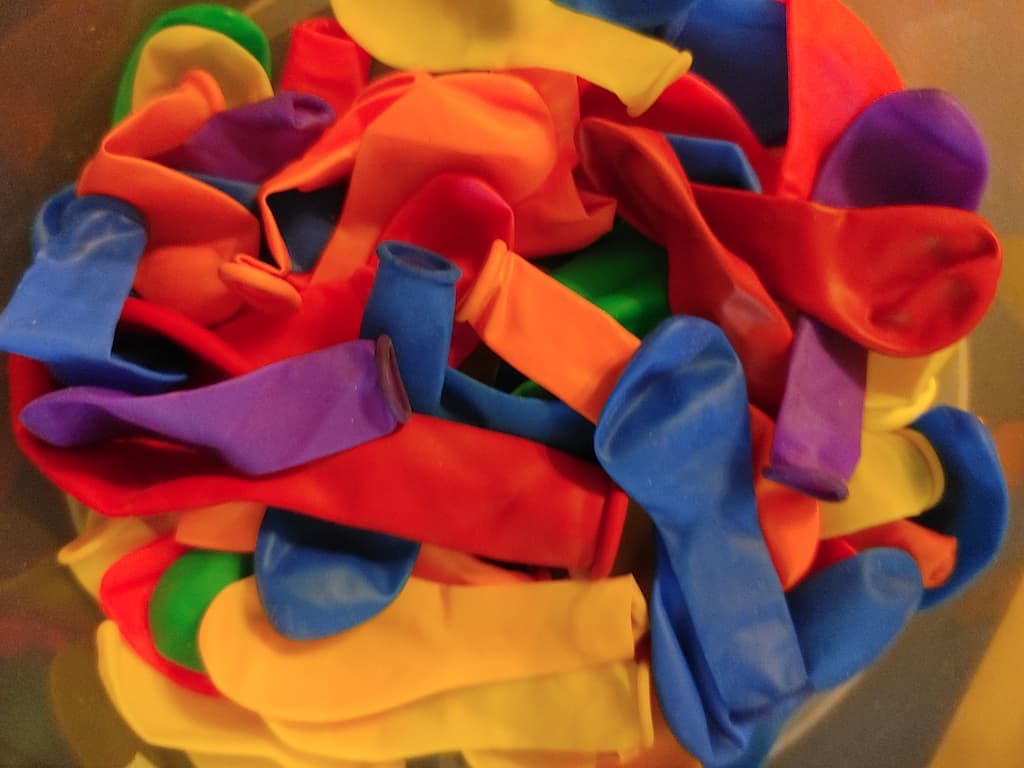
In this post, I’m going to introduce you to a brand new type of vocal exercise I’ve developed using a balloon, an alternative to the straw phonation exercises created by voice scientist Dr. Ingo Titze. Watch the embedded video demonstration featuring my friend Mark Thress.
Watch Video:
How Balloon Exercises Were Developed
Vocal coach Mark Thress, with whom I exchange classical and contemporary vocal lessons, introduced me to straw phonation using a cocktail (small diameter) straw. I found these quite useful in encouraging more breath efficiency, as long as I pulled back as I blew forward. Neither one of us prefers using a bigger straw.
After working with the small straw for a few weeks, I started wondering what effect using a balloon instead of the straw would be. So I bought a package of assorted small balloons and started experimenting on my own, then with Mark, then with students. I found that most of us preferred and benefitted from the balloon instead of the straw!
Balloon vs Straw Comparisons:
- I believe they are both SOVT exercises.
SOVT, short for semi-occluded vocal tract exercises, include the lip bubble, tongue trill, raspberry, blowing through a hole in the bottom of a cup, and the straw. According to the excellent, detailed article on straw phonation at VoiceScienceWorks,
“SOVT exercises lengthen the vocal tract and narrow the opening, creating increased acoustic back pressure that helps the vocal folds vibrate more easily.”
- The balloon is stretchy, the straw is stiff.
The malleable balloon skin responds to vocal sound with more nuanced feedback than the straw. The vocalist must blow with more nuanced control to sound the balloon properly, requiring a finer degree of breath efficiency to open the balloon but not ‘blow it into next week!”
- The balloon requires that less breath pressure be used than the straw.
- ‘Pulling’ up and back while using the balloon also opens and relaxes the throat.
I experience the same thing with the straw, but find it easier to open the throat tract in more nuanced ways with the balloon.
- Most prefer the small size of both straw and balloon.
The best results I’ve found myself and with my students is with the smallest (2″) water balloon, but sometimes I have students alternate from the small one to a little larger one and back… just to challenge the ever-changing degree of required breath balance.
- Both the straw and balloon can be used with any scale or song melody.
After you get the hang of using the balloon in scales, try voicing a melody with it.
- Both the straw and balloon are useful for both the singing and speaking voice. Speakers can just exercise by sirens or slurs throughout all registers of the voice.
Gratitude for the Straw
I want to take a moment and state how grateful I am for the genius of Dr. Titze in developing his straw phonation exercises. They have been instrumental in many a singer and speaker’s vocal healing, and this in no way diminishes my utmost respect for them. I humbly offer this alternative exercise protocol to the voice community with full understanding that without the straw, the balloon would never have come to mind!
I need your input!
- Will you try the balloon? If so,
- What was your experience with balloon exercises?
- What questions do you have about doing them?
- What suggestions would you make?

Thank you Judy, I will try this technique, I think it may be better than the straw! keepupgoodworks
Great, please let me know about your experience with the balloon! Thanks much.
Really looking forward to trying this. Many thanks!
Thank you Judy. I came to this blog through Liz Harley’s sharing of it on the Voice Geeks FB page. I look forward to trying this with my students online, hoping that they can get hold of a balloon! (I assume your video was made before lockdown!)
James… yes, this video was created before the coronavirus lockdown. As to finding balloons… get them mailed to you. There are lots of sources out there. Do an internet search for biodegradable small (I like the 2" best) balloons. Sometimes they are called water balloons. You may have to purchase a multiple size package, and pick out the sizes you want to try. AND, to be environmentally conscious, we can wash the balloons out, let them dry (I put them on straws to dry) and re-use them. Though it may take a couple of years, some claim they bio-degrade, so I use them. And I tell my students never to let them get into the ocean. I do hope they come up with a quickly-degradeable type of balloon material.
Awesome, Fiona… let me know how it goes!